
1. Fore wing with abscissa of M between rs-m and 2m-cu short, less than
0.5x rs-m (A); female ocelli distinctly reduced (POL > 1.5) (B);
ovipositor stout and evenly up-curved with apex down-curved (C);
female femoral tooth absent (FFT = 0) (C); south-western South
Africa ... 2

- Fore wing with abscissa of M between rs-m and 2m-cu longer, distinctly
longer than 0.5x rs-m (a); female ocelli larger (POL < 1.5) (b);
ovipositor straight to slightly down-curved, usually more slender and
apically unevenly sinuate (c); female femoral tooth present or
absent (FFT various) (c) ... 3
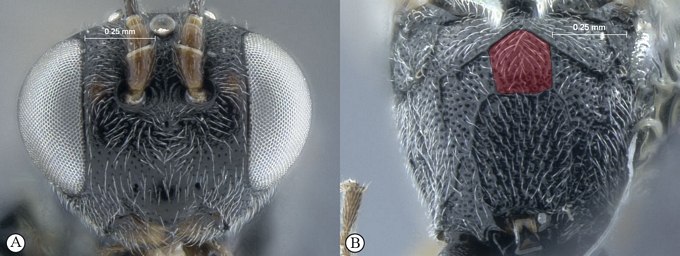
2. Face totally black, deeply and densely punctate, inter-puncture area
smooth (A); area superomedia subquadrate (ASM < 1) (B) ...
Pristomerus protea Rousse
& van Noort, 2015
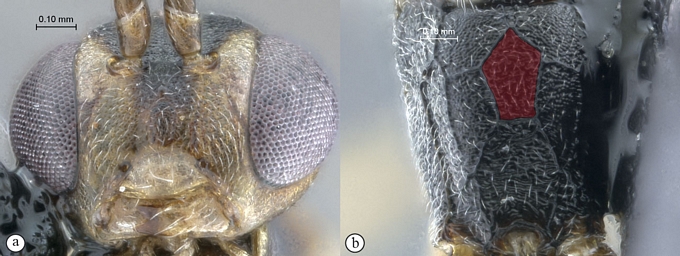
- Face mostly lighter, densely punctate-granulate (a); area superomedia
longer than wide (ASM > 1) (b) ...
Pristomerus restio Rousse
& van Noort, 2015
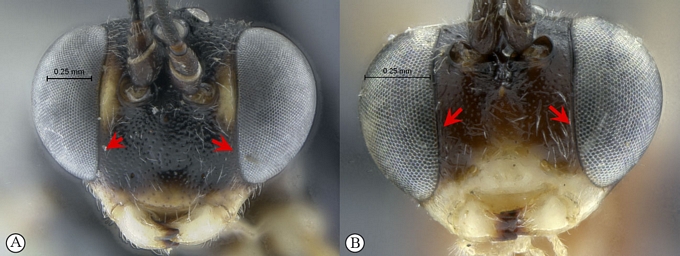
3. Entire face black to dark brown, including orbits (A,
B) ... 4
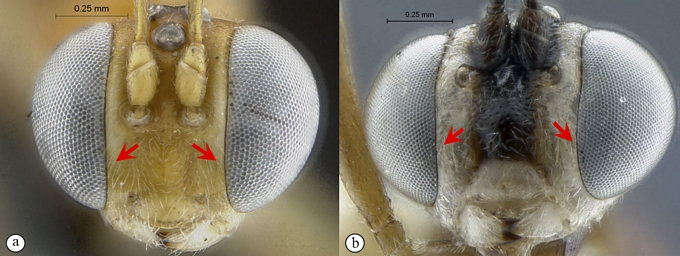
- At least facial orbits distinctly lighter, pale yellow to testaceous-orange
(a);
median face almost always similarly coloured though sometimes more
or less infuscate (b) ... 16
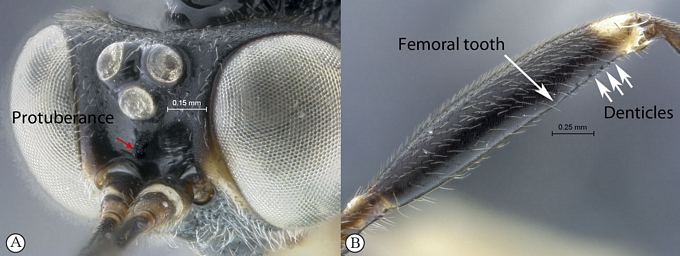
4. Frons with a strong mid-longitudinal flattened protuberance (A);
femoral tooth nearly absent with minute following denticles (B);
ovipositor short (OT < 1.5) ...
Pristomerus kuku Rousse
& van Noort, 2015
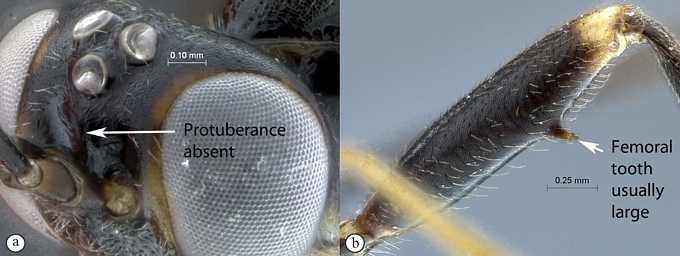
- Frons without distinct mid-longitudinal protuberance (a); femoral tooth
and ovipositor various, usually both longer (b) ... 5
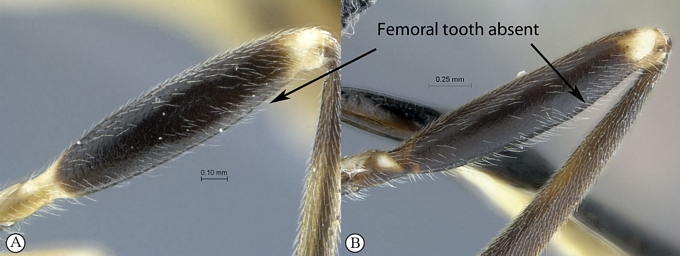
5. Female femoral tooth absent, femur without any distinct subapical
protuberance ventrally (FFT = 0) (A, B); tropical rainforest of central
mainland Africa ... 6
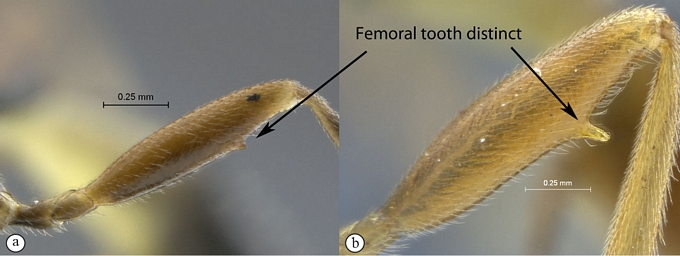
- Female femoral tooth distinct, small to very strong (FFT > 0) (a,
b) ... 7
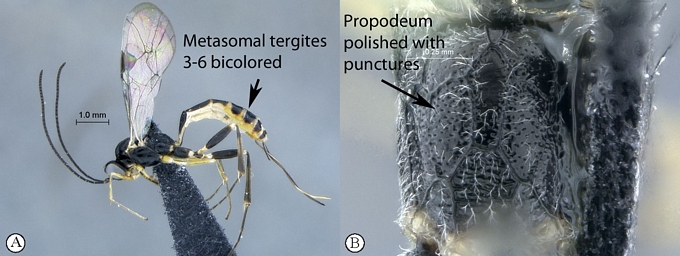
6. Female with tergites 3–6 bicolored, black and yellowish-orange (A);
propodeum polished with punctures (B) ...
Pristomerus tutsi
Rousse & van Noort, 2015
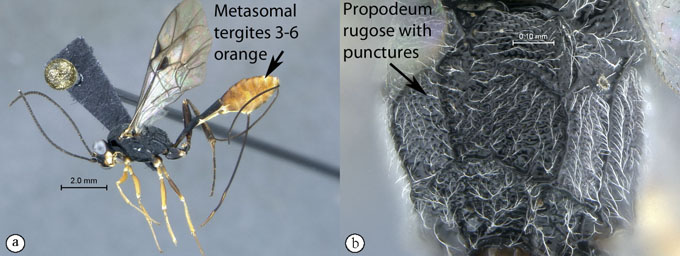
- Female with tergites 3–6 entirely orange (a); propodeum rugose with
punctures (b) ...
Pristomerus yangere Rousse
& van Noort, 2015

7. Scutellum smooth or nearly so, distinctly smoother than mesoscutum (A,
B, C)
... 8

- Scutellum distinctly punctate, punctation denser than on mesoscutum (a,
b, c)
... 10
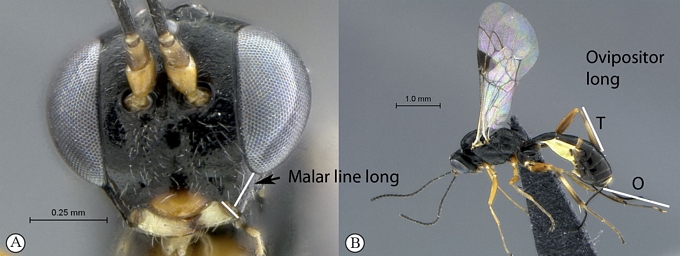
8. Small (fore wing length < 3.5mm); malar line very long (ML > 1.2x basal
mandible width) (A); ovipositor moderately long (OT > 1.5) (B); South
Africa ...
Pristomerus khoikhoi Rousse
& van Noort, 2015
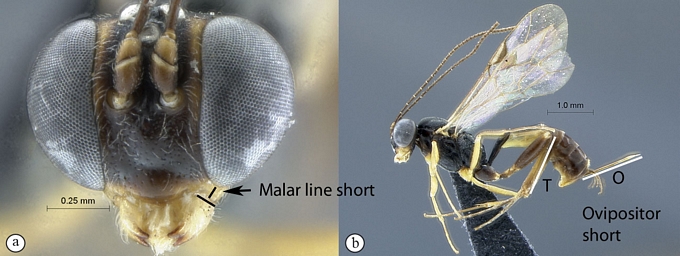
- Larger (fore wing length > 3.5mm); malar line short to very short (ML <
0.7x basal mandibular width) (a); ovipositor short (OT < 1.5) (b);
tropical rainforest of central mainland Africa ... 9
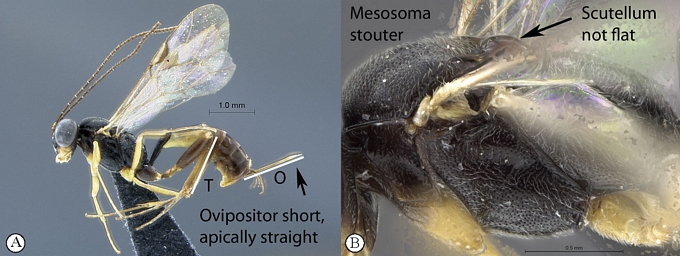
9. Ovipositor very short (OT < 1) and apically straight (A); mesosoma
rather stout, scutellum not unusually flat (A) ...
Pristomerus
mbaka Rousse & van Noort, 2015
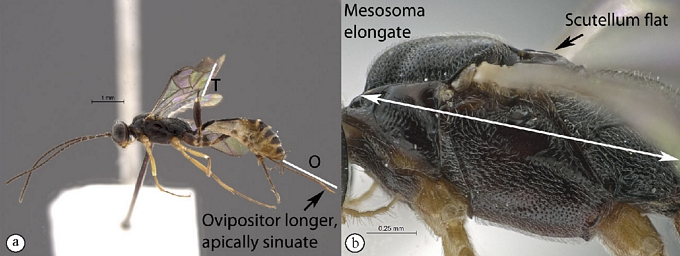
- Ovipositor longer (OT > 1) and apically sinuate (a); mesosoma distinctly
elongate with scutellum quite flat (b) ...
Pristomerus teke
Rousse & van Noort, 2015
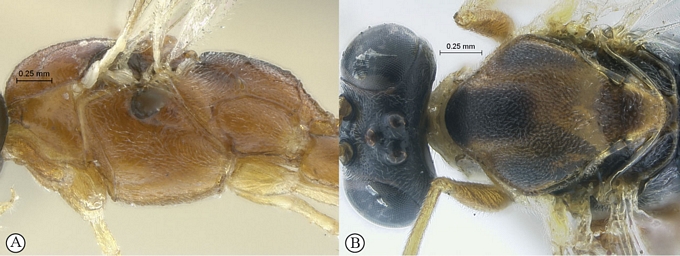
10. Mesosoma partly to totally yellowish-orange
(A) to testaceous (B);
Southern Africa and Indian Ocean islands ... 11
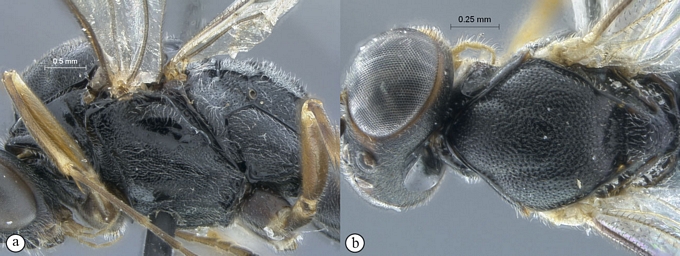
- Mesosoma entirely black (a, b); tropical mainland Africa ... 13
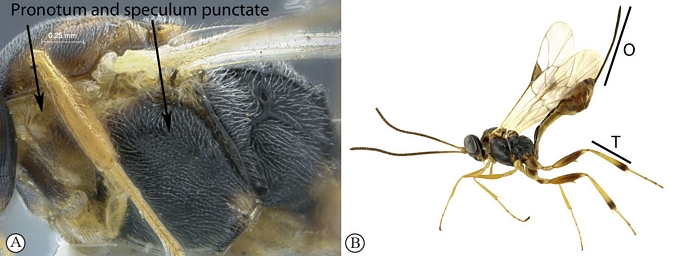
11. Speculum and pronotum entirely punctate (A); ovipositor long (OT >
1.5) (B); Réunion ...
Pristomerus rivier Rousse & Villemant, 2012
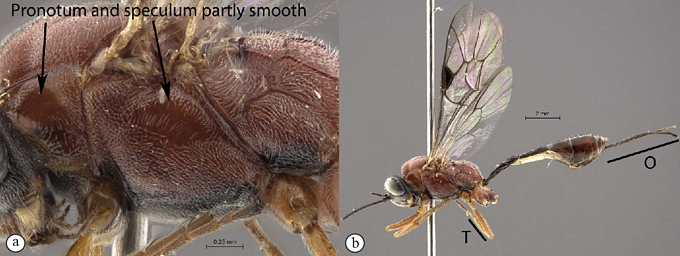
- Pronotum centrally and ventral half of speculum smoother (a); ovipositor
short (OT < 1.5) (b) ... 12
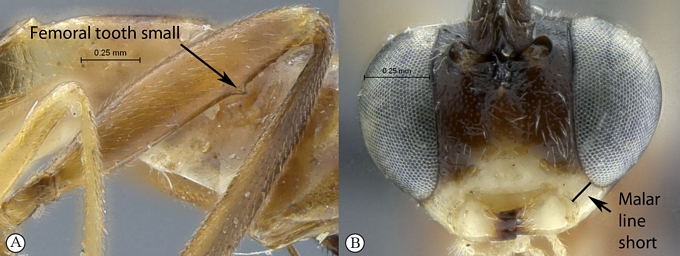
12. Female femoral tooth distinctly smaller than basally wide (FFT = 1)
(A); malar line short (ML < 0.6) (B); Madagascar ...
Pristomerus
melissa Rousse, Villemant & Seyrig, 2013
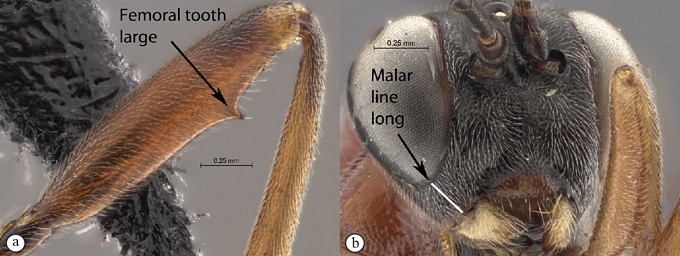
- Female femoral tooth longer than basally wide, apically lamellar (FFT =
2) (a); malar line long (ML > 0.6) (b); Southern Africa ...
Pristomerus sotho
Rousse & van Noort, 2015
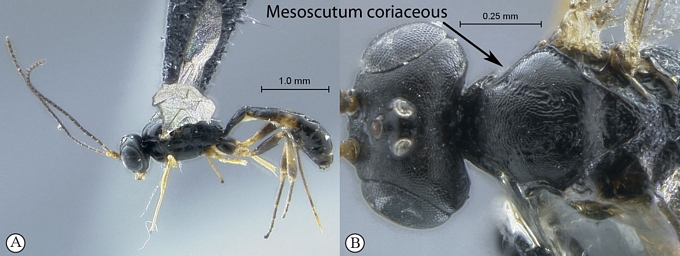
13. Small (fore wing length < 3.5mm) (A); mesoscutum coriaceous without
punctures (B) ...
Pristomerus aka
Rousse & van Noort, 2015
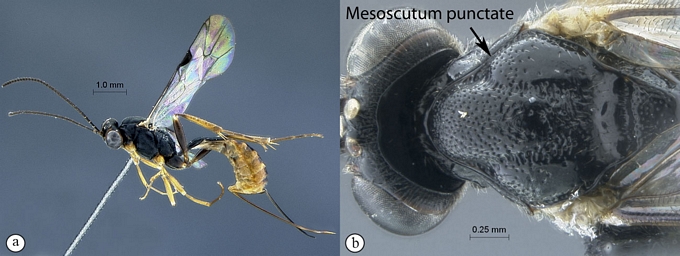
- Larger (fore wing length > 3.5mm) (a); mesoscutum distinctly punctate (b) ...
14

14. Speculum entirely punctate (A); propodeum with area basalis strongly
petiolate (B); female femoral tooth strongly shorter than basally
wide (FFT = 1) (C); antenna with less than 32 flagellomeres ...
Pristomerus
mbama Rousse & van Noort, 2015

- Speculum distinctly smoother ventrally (a); propodeum with area basalis
widely sessile (b); female femoral tooth strongly longer than
basally wide (FFT = 2) (c); antenna with more than 32 flagellomeres ... 15
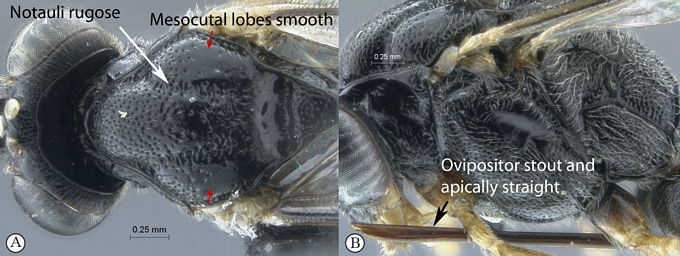
15. Notauli coarsely rugose and lateral lobes of mesoscutum apically
nearly smooth (A); ovipositor stout and apically straight (B) ...
Pristomerus nzakara
Rousse & van Noort, 2015
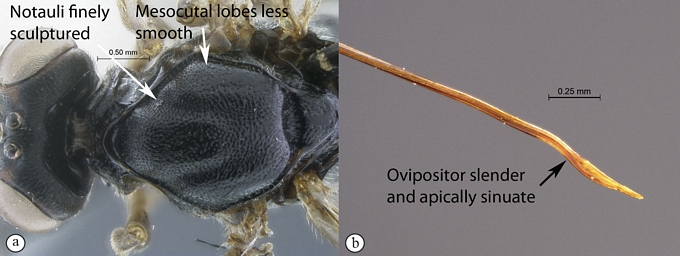
- Notauli more finely sculptured and lateral lobes of mesoscutum apically
more uniformly punctate (a); ovipositor slender and apically sinuate
(b) ...
Pristomerus dikidiki
Rousse & van Noort, 2015
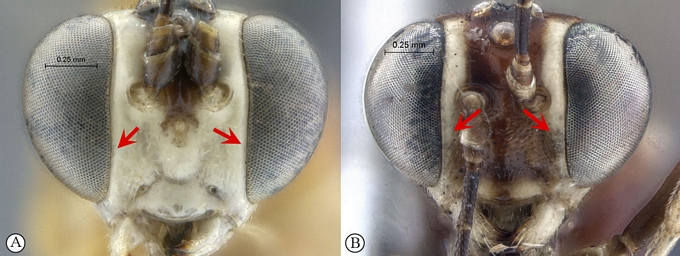
16. Facial orbits, and most often entire face, whitish (A,
B); Madagascar
and Southern Africa ... 17
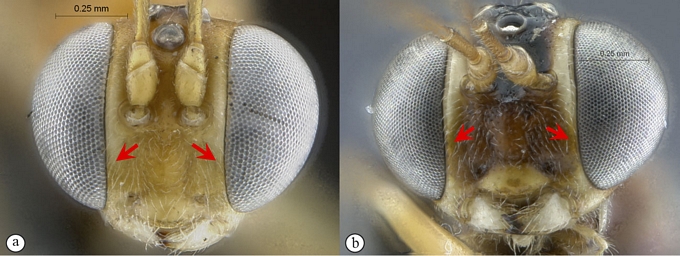
- Facial orbits, and most often entire face, yellow to testaceous orange
(a, b) ... 22
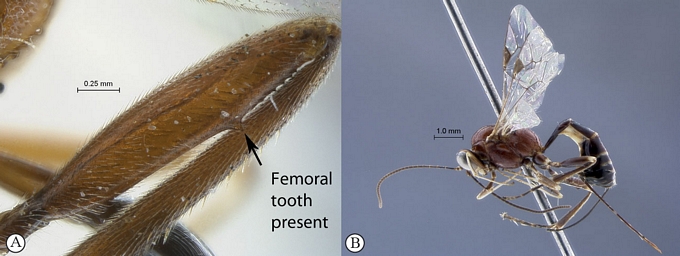
17. Female femoral tooth present (FFT > 0) (A); metasoma mostly black
with apical margin of most tergites white (B); Madagascar and South
Africa ... 18
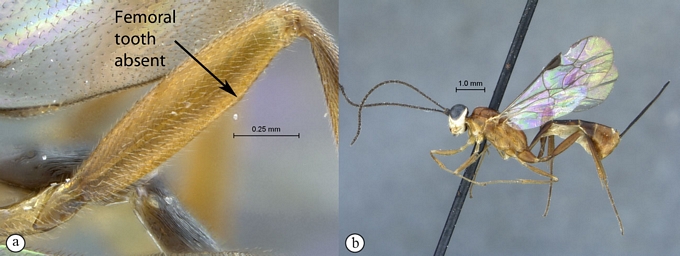
- Female femoral tooth totally absent (FFT = 0) (a); metasoma differently
coloured, mostly orange with sometimes infuscate markings (b);
Madagascar ... 19
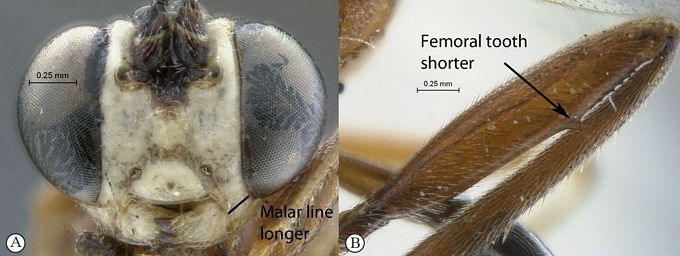
18. Face entirely whitish, malar line moderately long (ML > 0.5) (A);
hind femur uniformly orange, female femoral tooth nearly as long as
basally wide (FFT = 1–2) (B); Madagascar ...
Pristomerus guinness
Rousse, Villemant & Seyrig, 2013
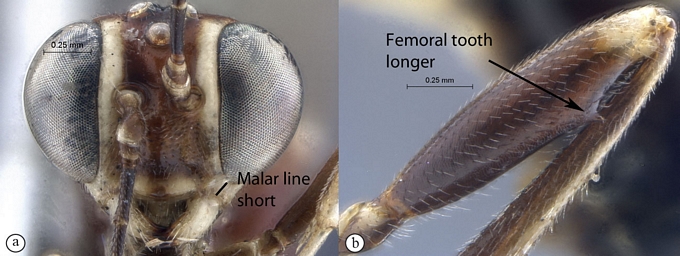
- Face medially testaceous, malar line short (ML < 0.5) (a); hind femur
testaceous, apically pale, female femoral tooth distinctly longer
than basally wide (FFT = 2) (b); South Africa ...
Pristomerus
zulu Rousse & van Noort, 2015
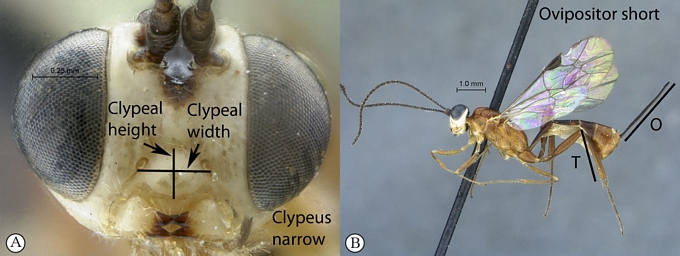
19. Clypeus narrow (CT < 1.7) (A); ovipositor short (OT < 1.5)
(B) ...
Pristomerus vahaza Rousse, Villemant & Seyrig, 2013
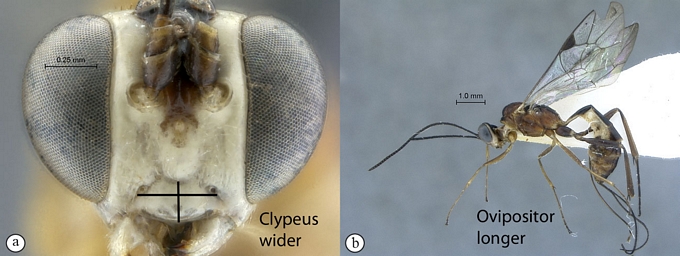
- Clypeus wider (CT > 1.7) (a); ovipositor longer (OT > 1.5)
(b) ... 20
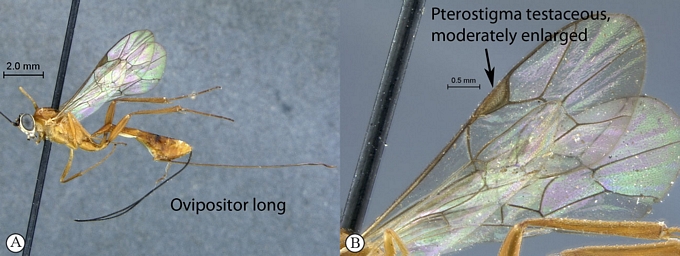
20. Ovipositor very long (OT > 2.5) (A); pterostigma light testaceous,
moderately enlarged (B) ...
Pristomerus hansoni Rousse,
Villemant & Seyrig 2013
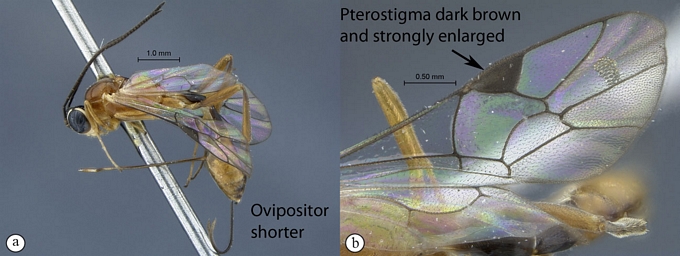
- Ovipositor shorter (OT < 2.5) (a); pterostigma dark brown and strongly
enlarged (b) ... 21
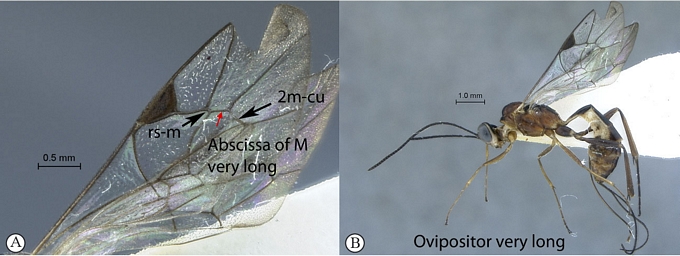
21. Fore wing with abscissa of M between rs-m and 2m-cu very long, far
longer than rs-m (A); ovipositor very long (OT > 2.0) (B) ...
Pristomerus ranomafana Rousse, Villemant & Seyrig, 2013
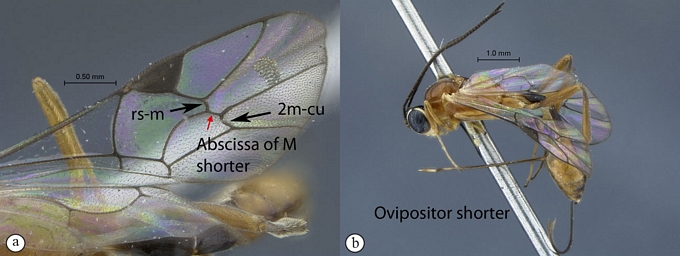
- Fore wing with abscissa of M between rs-m and 2m-cu shorter, about as
long as rs-m (a); ovipositor shorter, moderately long (OT < 2.0)
(b) ...
Pristomerus caris Fitton, 1994
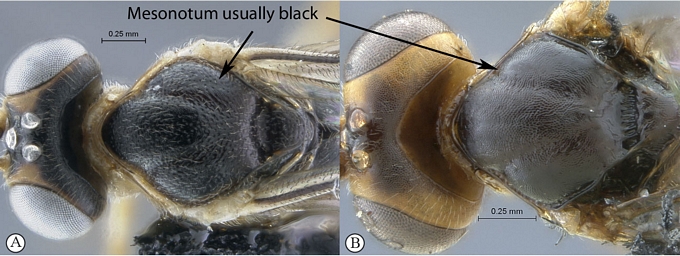
22. Mesonotum usually entirely black (A, B), sometimes mesoscutum partially
lighter with scutellum totally black; female femoral tooth always
distinct though sometimes reduced (FFT > 0) ... 23
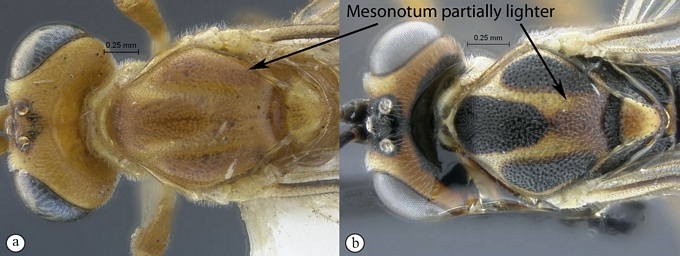
- Mesonotum nearly always distinctly lighter, yellowish orange to
partially testaceous (a, b); female femoral tooth variable; if, rarely, mesoscutum almost entirely dark testaceous (some
Pristomerus
moramora), then female femoral tooth absent (FFT = 0) ... 24
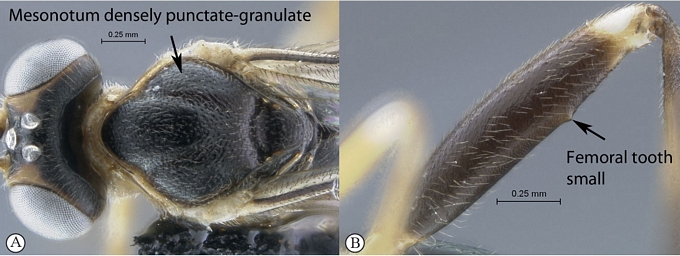
23. Mesonotum densely punctate-granulate, punctures somewhat confluent
along notaulus line (A); femoral tooth weak (B); tropical central
Africa ...
Pristomerus hutu
Rousse & van Noort, 2015
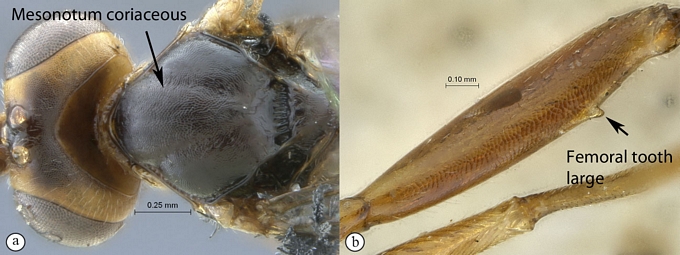
- Mesonotum coriaceous, without punctures (a); femoral tooth strong (b);
Seychelles ...
Pristomerus ruficaput (Morley, 1912)
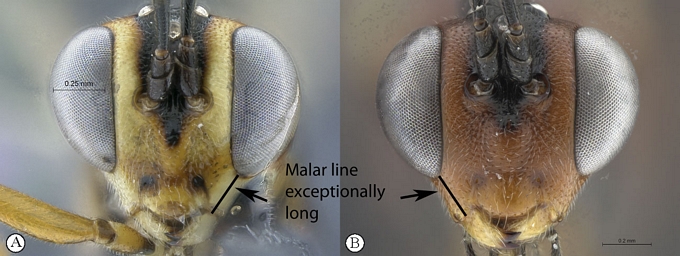
24. Malar line exceptionally long, longer than mandible base (ML > 1) (A,
B); South Africa ... 25
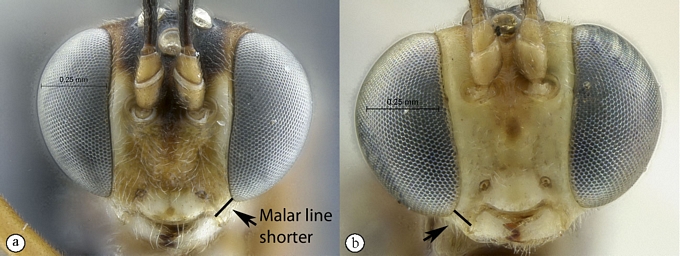
- Malar line shorter, usually much shorter than mandible base (ML < 1) (a,
b) ... 26
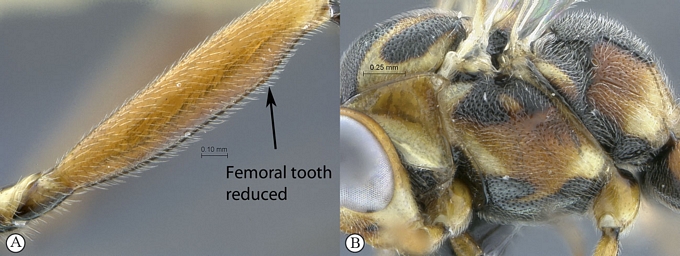
25. Femoral tooth reduced to a subapical point, followed by minute
denticles (A); mesosoma mottled black, orange and pale yellow (B)
...
Pristomerus xhosa
Rousse & van Noort, 2015
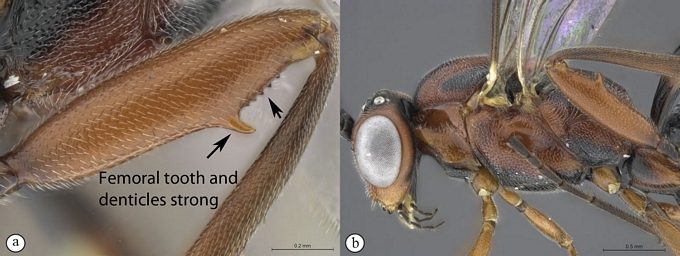
- Femoral tooth strong, followed by 5 strong denticles (a);
mesosoma
reddish-orange with black markings (b) ...
Pristomerus kagga
Rousse & van Noort, 2015

26. Ovipositor tip straight (A); clypeus unusually narrow and long (CT =
1.5) with eyes slightly converging ventrally (B); small (F ≤ 3.5);
female femoral tooth present but often hardly distinct (C);
Madagascar, Eastern and Southern Africa ...
Pristomerus albescens
(Morley, 1917)
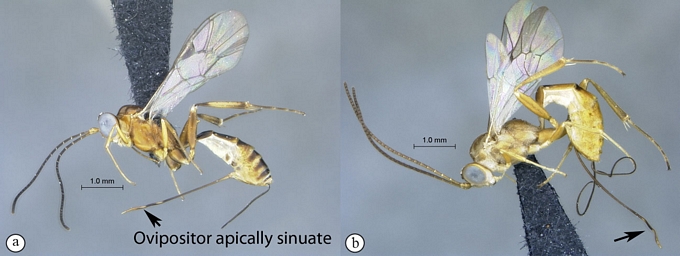
- Ovipositor most often at least slightly sinuate apically (a,
b); if,
rarely, ovipositor tip barely sinuate, then not fully agreeing with
the above combination ... 27
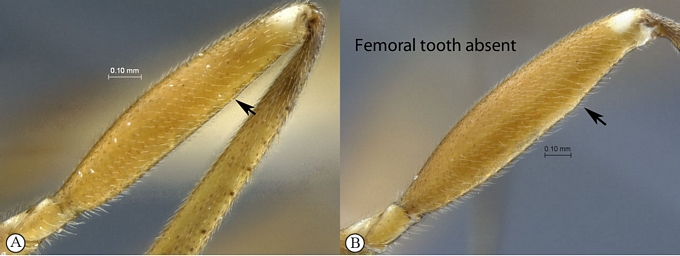
27. Female femoral tooth totally absent, not even distinct as a subapical
protuberance, and never with following denticles (FFT = 0) (A, B)
... 28
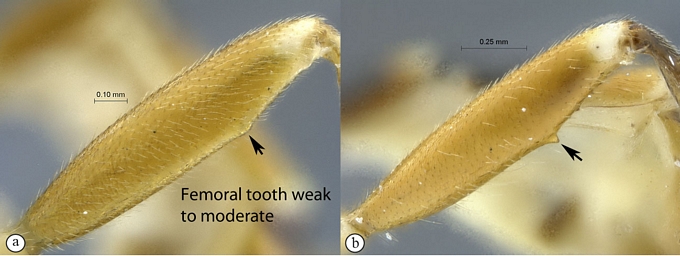
- Female femoral tooth weak to moderate, at least distinct as a subapical
ventral protuberance (a) and distinctly shorter than basally wide,
sometimes followed by secondary denticles (FFT = 1) (b) ... 34
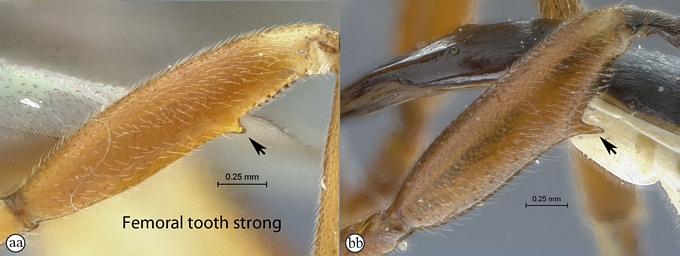
- Female femoral tooth strong, about as high as wide
(aa) to strongly higher
than basally wide (bb), always followed by secondary denticles (FFT
= 2) ... 42
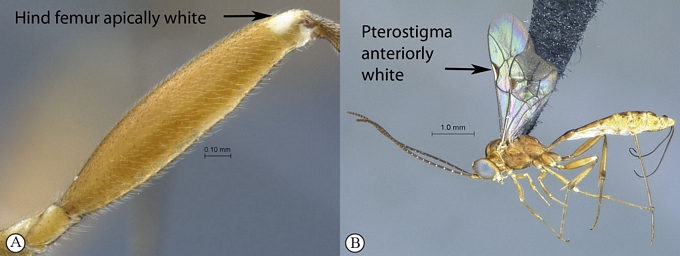
28. Hind femur, and often other femora, with an obvious apical white
patch (A); anterior margin of pterostigma white (B); tropical
mainland Africa ... 29
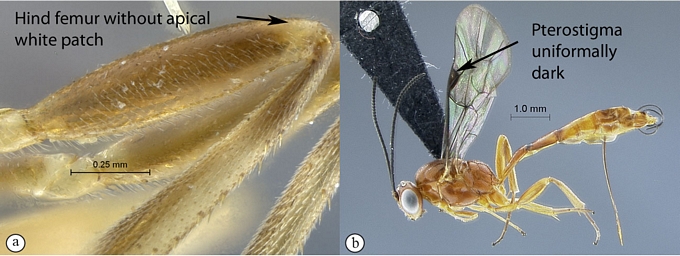
- Femora without distinct apical white patches, though often lighter
apically (a); pterostigma uniformally dark (b); southern Africa and
Madagascar ... 30
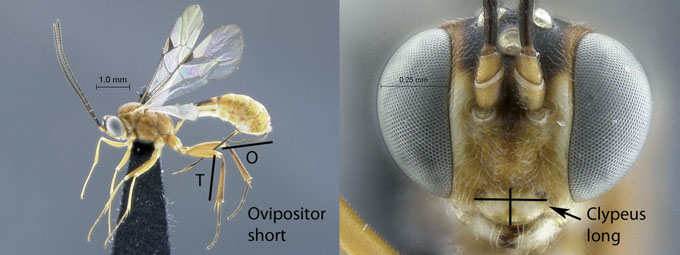
29. Ovipositor short (OT < 1.4) and apically nearly straight (A); clypeus
long (CT < 2) (B) ...
Pristomerus zande
Rousse & van Noort, 2015
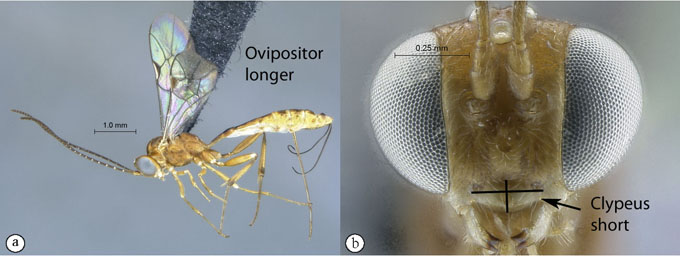
- Ovipositor moderately long (OT > 1.4), apically sinuate (a); clypeus
short (CT > 2) (b) ...
Pristomerus sara
Rousse & van Noort, 2015
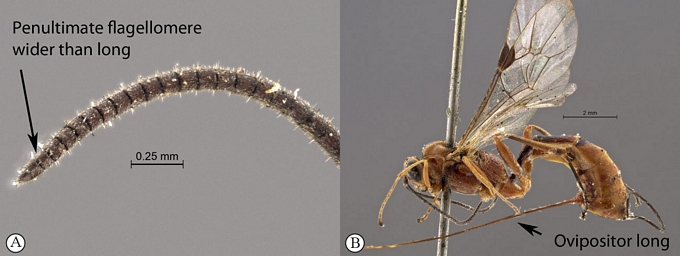
30. Penultimate flagellomere distinctly wider than long (Fln-1 ≤ 0.9)
(A); large (F > 5 mm); ovipositor very long (OT > 2.0) (b); Namibia
...
Pristomerus herero
Rousse & van Noort, 2015 (in part)
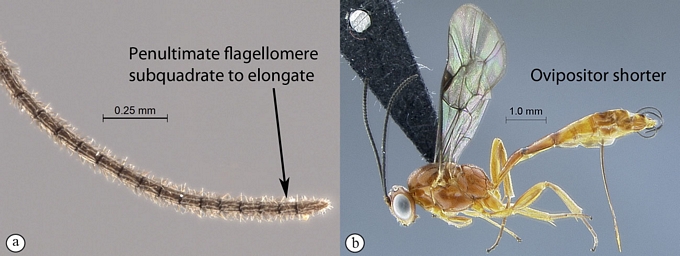
- Penultimate flagellomere subquadrate to distinctly elongate (a);
distinctly smaller (F < 5 mm); ovipositor shorter (OT < 2.0) (b) ...
31
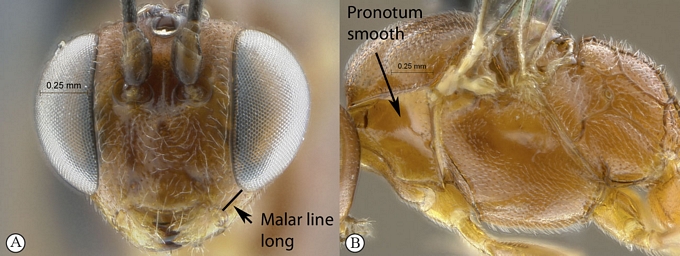
31. Malar line rather long (ML > 0.5) (A); pronotum almost entirely
smooth with some punctures postero-dorsally (B); ovipositor
moderately short (OT < 1.6); entire body without obvious dark
markings except sometimes some infuscate markings around scutellum
and on basal tergites; Southern Africa ...
Pristomerus san
Rousse & van Noort, 2015
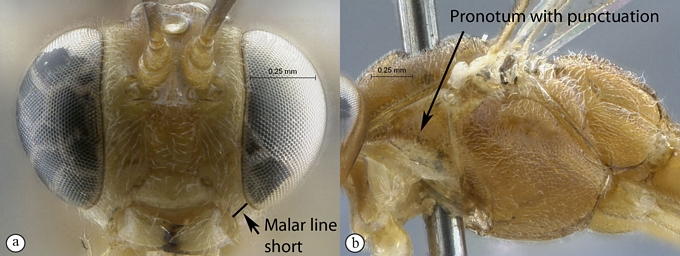
- Malar line short (ML < 0.5) (a); pronotum more extensively punctate (b);
ovipositor usually longer (OT > 1.5); color various, often with
large brown to black dorsal markings ... 32
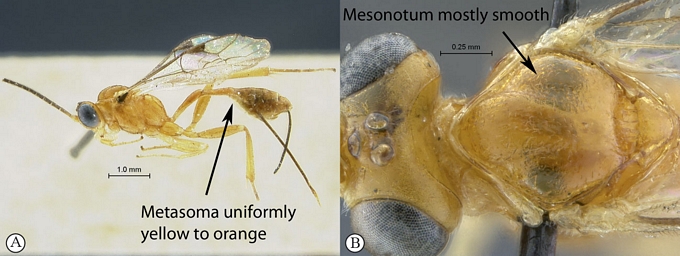
32. Metasoma uniformly yellow to orange (A); mesonotum almost smooth,
only scutellum and apex of mesoscutum weakly punctate (B); antenna
with more than 30 flagellomeres; Madagascar ...
Pristomerus
kelikely Rousse, Villemant & Seyrig, 2013
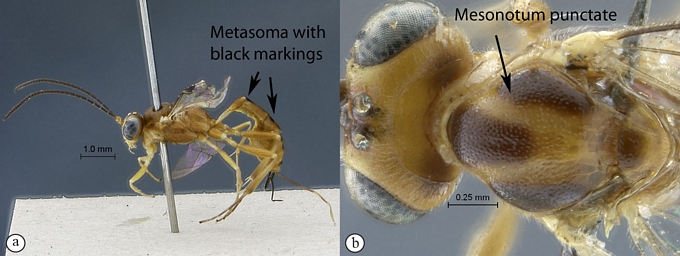
- Metasoma with at least basal tergites distinctly black maculated (a);
entire mesonotum distinctly punctate (b); antenna with at most 30
flagellomeres ... 33
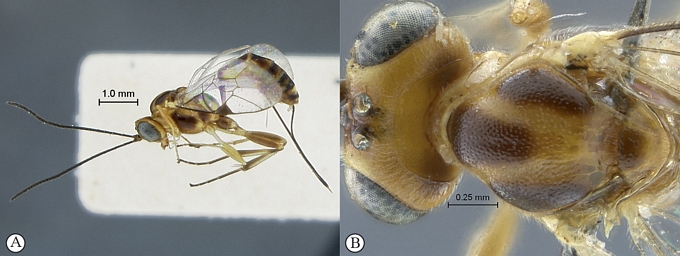
33. Dark markings of body strongly extended: all metasomal tergites
largely black maculated (A), mesosoma with dark testaceous markings
dorsally and laterally (A, B); male with ocelli hardly enlarged (OOL
1.0) and inner margins of eyes subparallel; Madagascar ...
Pristomerus moramora Rousse, Villemant & Seyrig, 2013
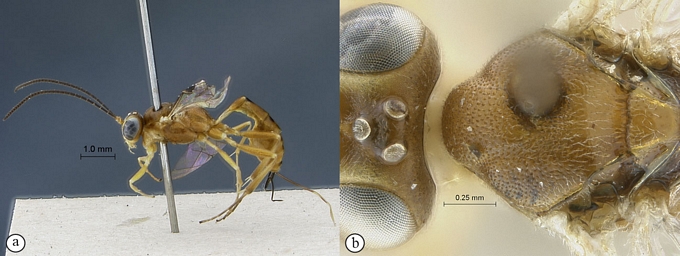
- Body lighter, with only basal tergites partially dark (a), mesosoma
uniformly pale (a, b), but sometimes with infuscate markings around
scutellum; male with ocelli strongly enlarged (OOL < 0.1) and inner
margins of eyes diverging ventrally; Southern Africa ...
Pristomerus venda
Rousse & van Noort, 2015
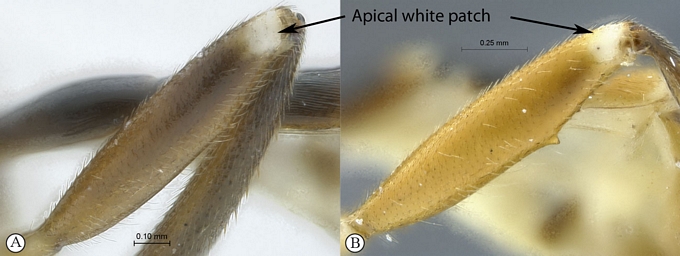
34. Hind femur, and often other femora, with an obvious apical white
patch (A, B); tropical mainland Africa ... 35
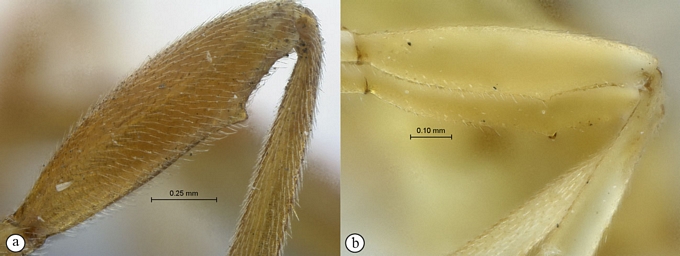
- Femora without a distinct apical white patch
(a), though often lighter
apically (b) ... 37
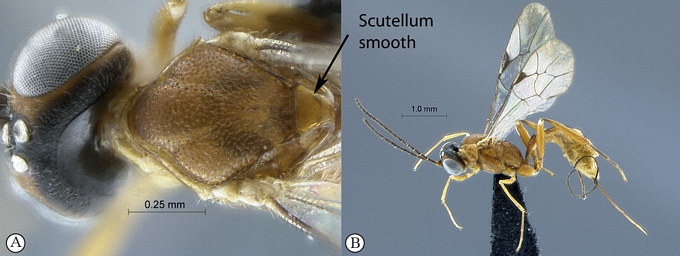
35. Scutellum smooth (A) ...
Pristomerus mboum
Rousse & van Noort, 2015
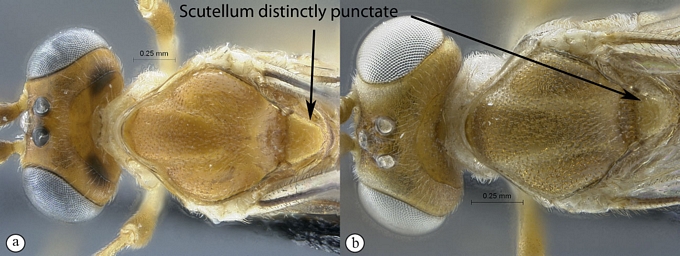
- Scutellum distinctly punctate (a, b) ... 36

36. Ocelli enlarged, posterior ocelli close together (POL < 0.8) (A);
tergites 1–3 at least half black, and occiput black-maculated in
female (B); femoral tooth moderate in female (C) (very strong and
acute in male); widespread in tropical Africa ...
Pristomerus
masai Rousse & van Noort, 2015

- Ocelli not enlarged, posterior ocelli more widely separated (POL > 0.8)
(a); tergites 1–3 mostly yellow, at most basally blackened, and
occiput not black-maculated (b); femoral tooth strongly reduced in
female (c) (moderate in male); Western Africa ...
Pristomerus
wolof Rousse & van Noort, 2015
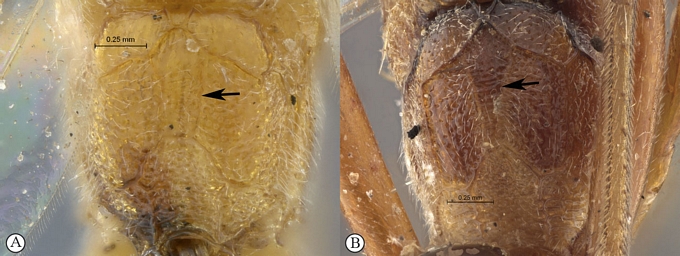
37. Area superomedia not defined postero-laterally (fully carinated in
male of
Pristomerus herero) (A, B); large wasps (F > 6 mm);
ovipositor long (OT > 1.7) ... 38
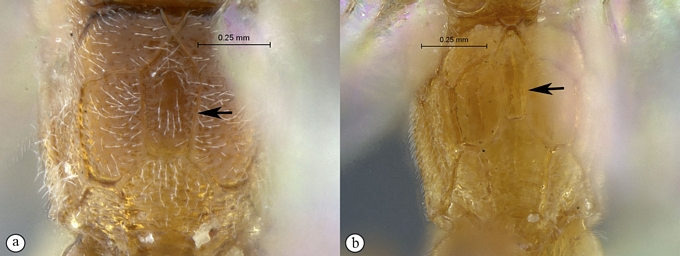
- Area superomedia most often fully delimited (a), though sometimes weakly
so in
Pristomerus keyka (b) but then specimens very small
(F < 4.5 mm); otherwise small to moderately large wasps (F < 5.5
mm); ovipositor variable ... 39
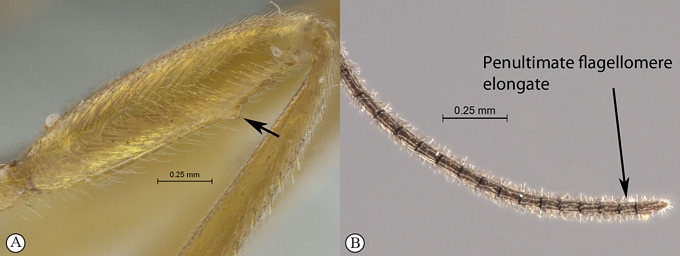
38. Female femoral tooth moderate in size (A); antenna with more than 35 flagellomeres, penultimate flagellomere elongate (B);
Madagascar ...
Pristomerus patator Rousse, Villemant &
Seyrig, 2013
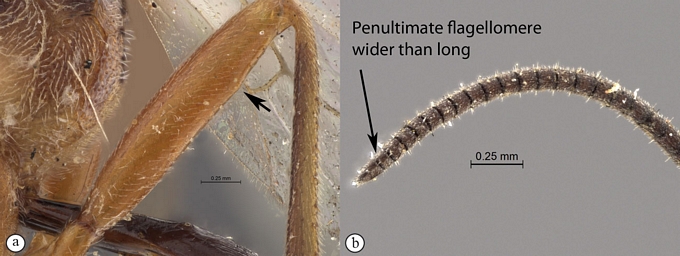
- Female femoral tooth reduced to a subapical protuberance followed by
small denticles (a); antenna with less than 35 flagellomeres,
penultimate flagellomere transverse (b); Namibia ...
Pristomerus
herero Rousse & van Noort, 2015 (in part)
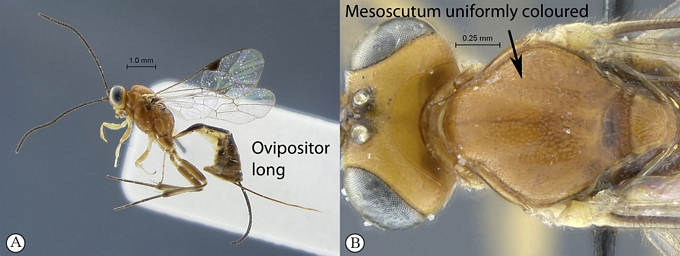
39. Ovipositor long (OT > 1.7) (A); notauli concolourous with remainder of
mesoscutum (B); Madagascar ... 40
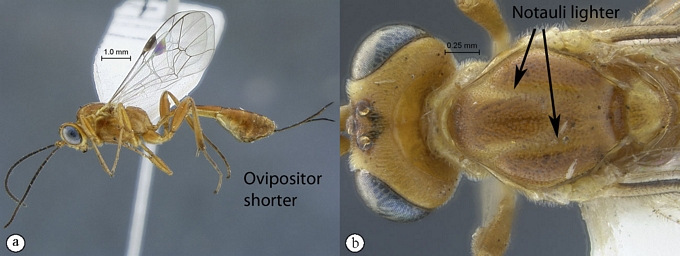
- Ovipositor shorter (OT < 1.7) (a); notauli often distinctly lighter than
remainder of mesoscutum (b) ... 41
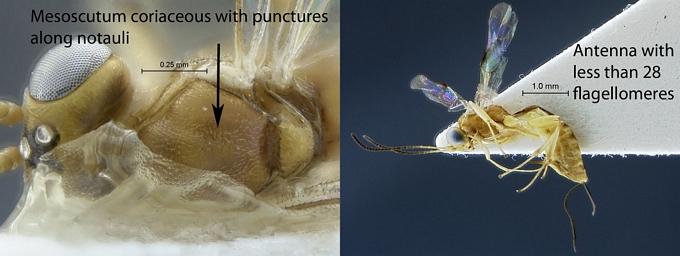
40. Mesoscutum coriaceous with punctures along notauli lines (A); small
species (F < 3.2) (B); antenna with less than 28 flagellomeres (B)
...
Pristomerus keyka Rousse, Villemant & Seyrig, 2013
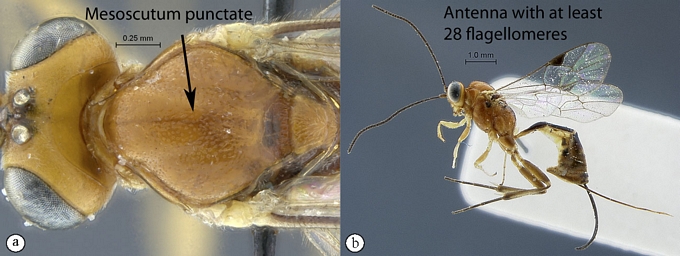
- Mesoscutum distinctly punctate (a) (coriaceous in male); larger species
(F > 3.2) (b); antenna with at least 28 flagellomeres (b) ...
Pristomerus roberti Rousse, Villemant & Seyrig, 2013

41. Clypeus strongly transverse (CT > 2.4) (A); female femur unusually
stout (B); ovipositor short (OT ≤ 1.3) (C); body without dark
markings (C); Eastern Africa ...
Pristomerus bullis Fitton,
1994

- Clypeus less transverse (CT < 2.4) (a); female femur
more slender (b);
ovipositor longer (OT ≥ 1.3) (c); body most often with dark dorsal
markings (c) ...
Pristomerus pallidus Kriechbaumer, 1884
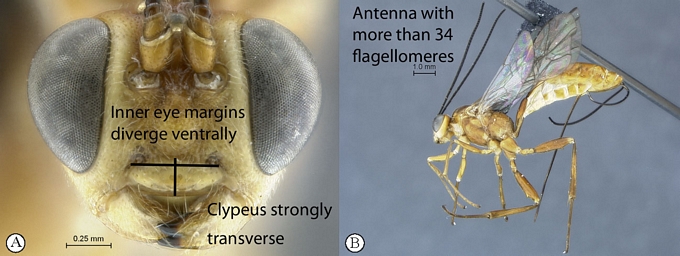
42. Clypeus strongly transverse (CT > 2.4) (A); inner margins of eyes
distinctly diverging ventrally (A); antenna with more than 34 flagellomeres (B); Central Africa ...
Pristomerus babinga
Rousse & van Noort, 2015
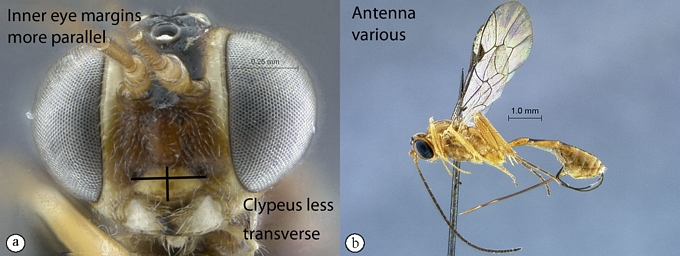
- Clypeus less transverse (CT < 2.4) (a); inner margins of eyes at most
slightly diverging ventrally (a); antenna various (b) ... 43
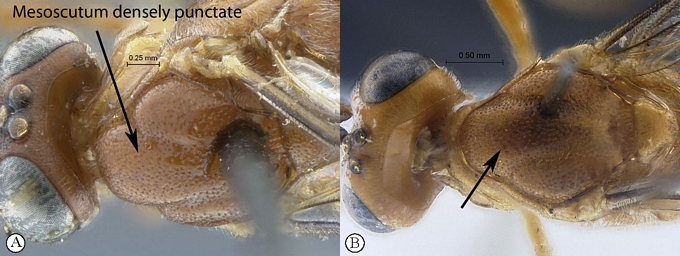
43. Mesoscutum, and often scutellum, densely punctate over entire surface
(A, B) ... 44
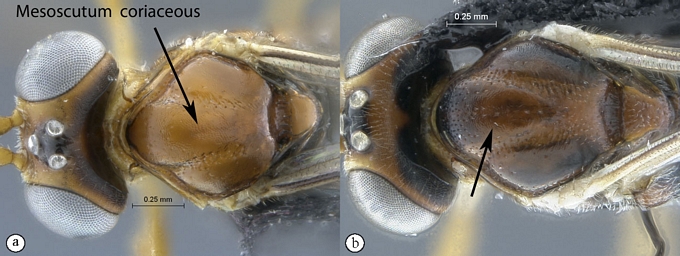
- Mesoscutum largely to entirely coriaceous, scutellum often quite smooth
(a, b) ... 46
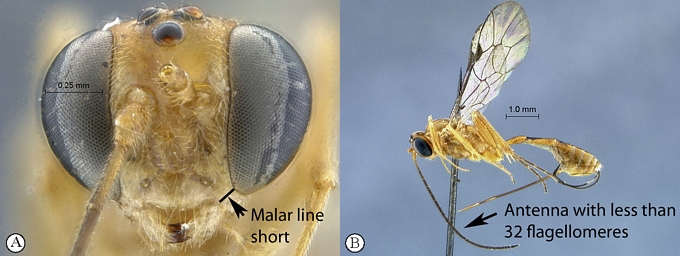
44. Malar line moderately short (ML < 0.6) (A); antenna with less than 32
flagellomeres (B); size moderate (F < 5.0) (B); Western Africa ...
Pristomerus yoccolo
Rousse & van Noort, 2015
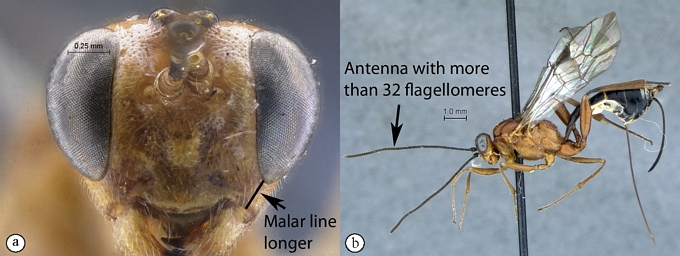
- Malar line moderately long (ML > 0.6) (a); antenna with more than 32
flagellomeres (b); large (F > 5.0) (b); South Africa and Madagascar
... 45
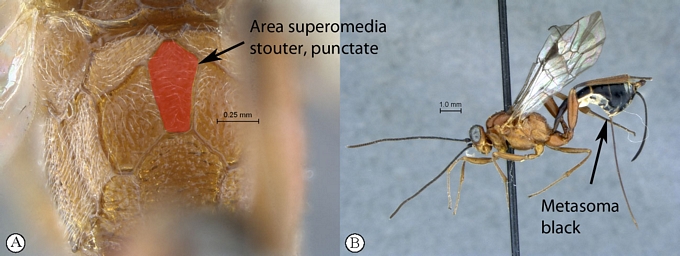
45. Area superomedia stouter (ASM < 1.8) and punctate (A); metasoma black
(B); Madagascar ...
Pristomerus veloma Rousse, Villemant &
Seyrig, 2013
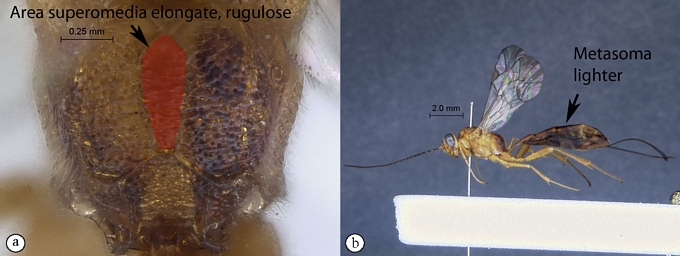
- Area superomedia elongate (ASM > 2.0) and transversely rugulose (a);
metasoma lighter (b); South Africa ...
Pristomerus afrikaner
Rousse & van Noort, 2015
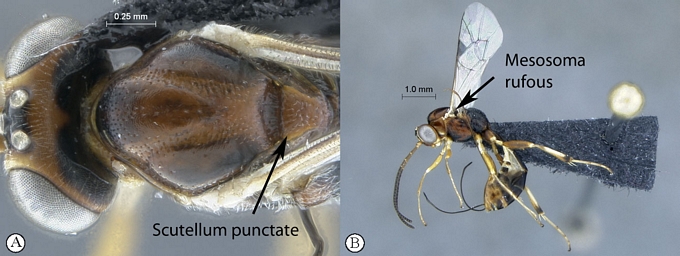
46. Scutellum punctate (A); antenna with less than 27 flagellomeres;
mesosoma rufous, ventrally and posteriorly black (B); tropical
Africa ...
Pristomerus bemba
Rousse & van Noort, 2015
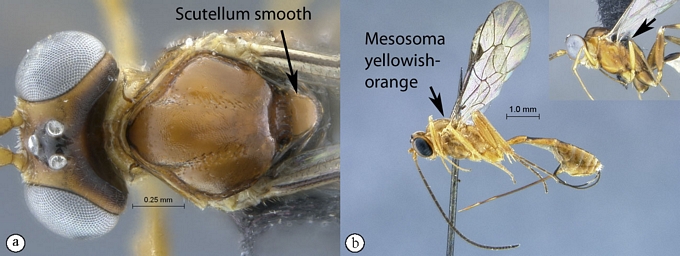
- Scutellum smooth (a); antenna with more than 27 flagellomeres; mesosoma
usually uniformly yellow to orange (b), postero-dorsally black in
Pristomerus swahili (b, inset) ... 47
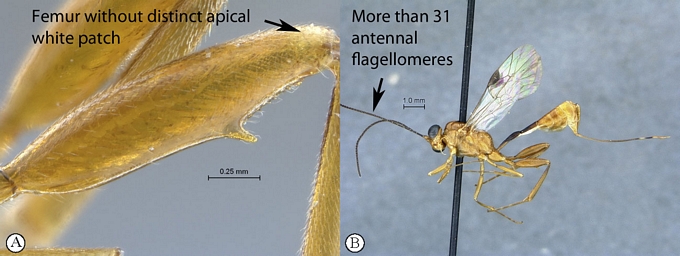
47. Femora and trochanters without obvious apical white patches (A);
antenna with more than 31 flagellomeres (B); Madagascar ...
Pristomerus yago Rousse, Villemant & Seyrig, 2013
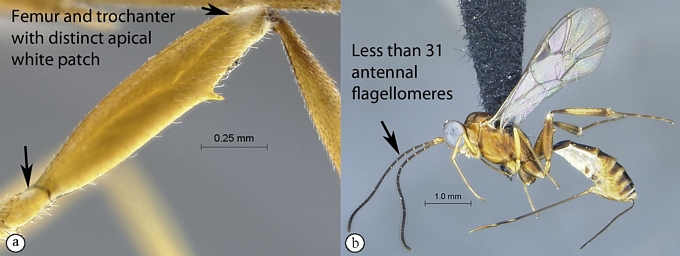
- Femora and trochanters with obvious apical white patches (a); antenna
with less than 31 flagellomeres (b); Eastern Africa ... 48
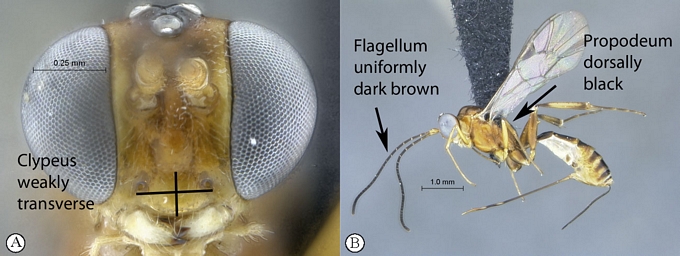
48. Clypeus weakly transverse (CT < 1.8)
(A); flagellum uniformly dark brown
(B); propodeum dorsally black (B) ...
Pristomerus swahili
Rousse & van Noort, 2015
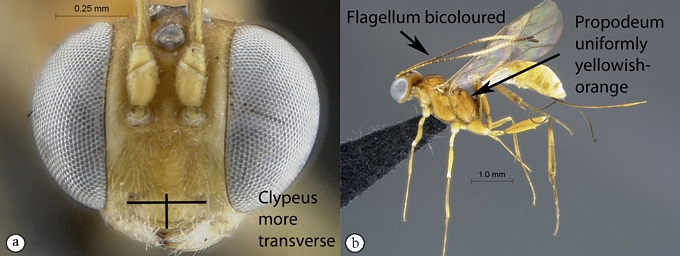 - Clypeus more transverse (CT > 1.8) (A); flagellum brown, basally distinctly
lighter and sometimes with a long whitish segment in apical half
(b); propodeum uniformly yellowish-orange (b) ...
Pristomerus
yakoma Rousse & van Noort, 2015
|